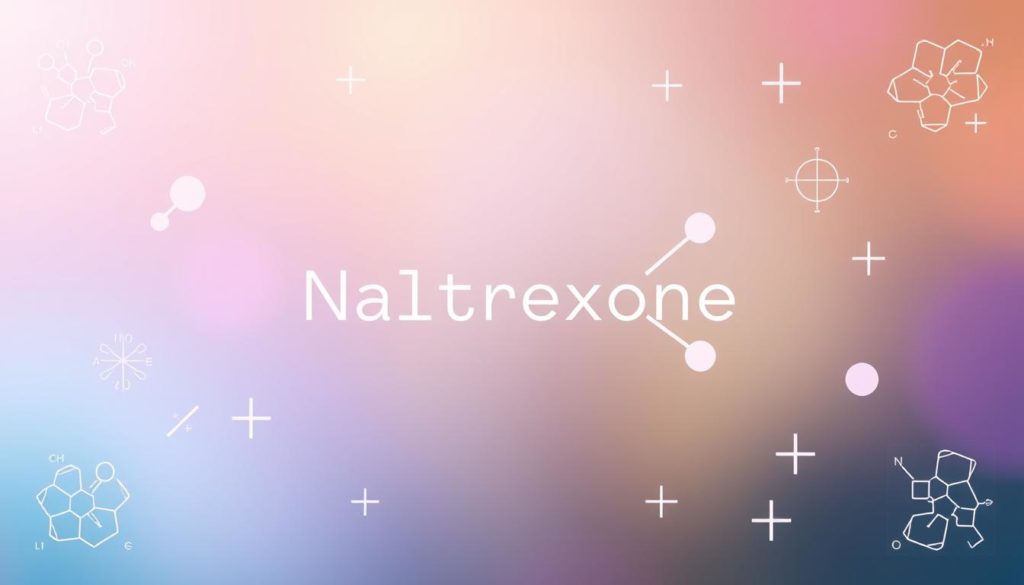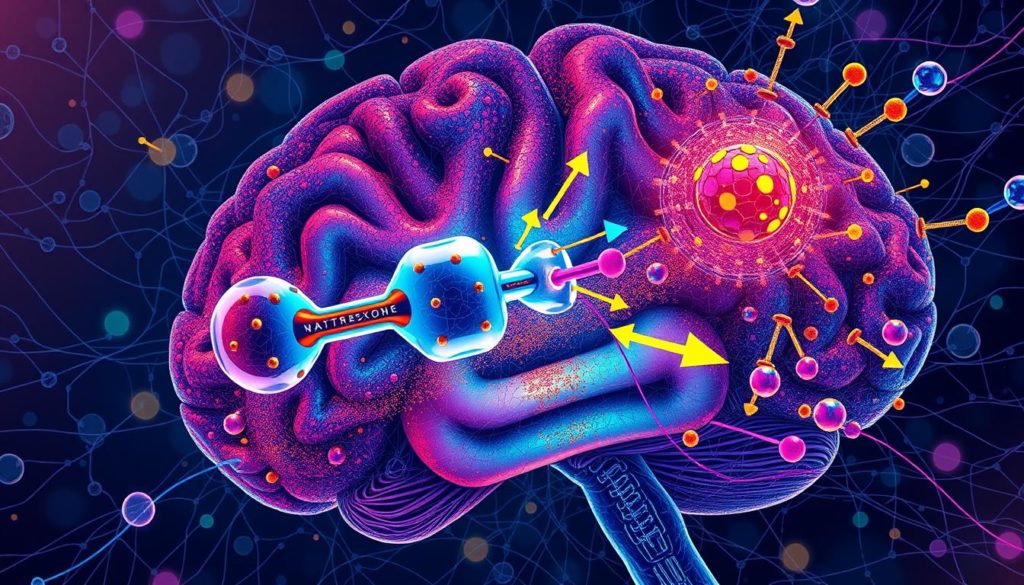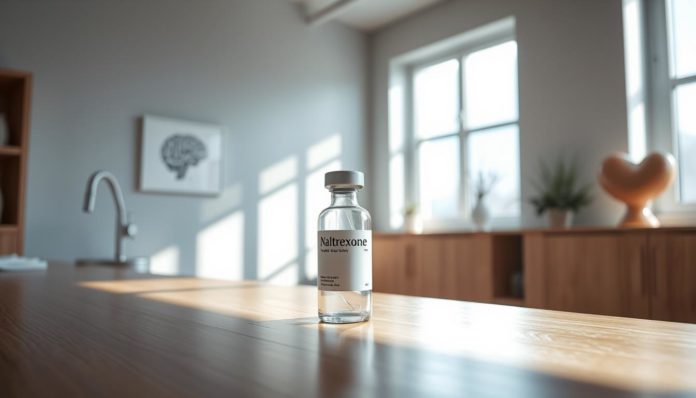Learn the key facts about Naltrexone, a vital drug for overcoming opioid addiction and alcohol dependence. It got the FDA’s nod and is a major part of treating substance abuse, especially for opioid and alcohol use disorders.
Naltrexone comes in pills or shots and is used by doctors in addiction treatment. But, it’s not for those under 18 or with some health issues.
Naltrexone is crucial in battling addiction with counseling and behavior therapies. Let’s explore this innovative treatment and its role in substance abuse recovery.
What Is Naltrexone?
Naltrexone is a key medication for fighting opioid and alcohol use disorders. The FDA has approved its use. It is known for being effective and versatile.

Definition and FDA Approval
The term Naltrexone definition denotes it as an opioid blocker. It prevents the happy and calming effects of drugs like heroin, morphine, and alcohol. Created in 1963 and patented four years later, the FDA approved it for addiction treatment. It’s now crucial in this fight.
Forms and Administration
Naltrexone comes in two forms, catering to different needs:
- Pill Form: It’s taken daily, mainly for alcohol addiction.
- Extended-Release Injectable: A healthcare provider gives this shot once a month. It’s for both alcohol and opioid addictions.
The naltrexone administration options give patients and doctors flexibility in treatment plans.
How Naltrexone Works
It’s vital to know how Naltrexone works if you’re thinking of using it for substance abuse treatment. As an opioid antagonist, it blocks the brain’s opioid effects. This is key in fighting addiction.

Mechanism of Action
Naltrexone works by attaching to the brain’s opioid receptors. This stops opioids from affecting these receptors. It cuts off their ability to make people feel euphoric or relieve pain. Naltrexone mainly targets the mu-opioid receptor but also affects kappa and delta-opioid receptors, though less strongly.
Impact on Opioid Receptors
Naltrexone, being an opioid antagonist, has no opioid-like effects and isn’t addictive. It also doesn’t lead to withdrawal symptoms when you stop taking it. By taking up space on opioid receptors, Naltrexone lowers cravings and the pleasure linked with opioid use. This is why it’s helpful in treating addictions to opioids like heroin, morphine, and codeine.
Using Naltrexone for Opioid Use Disorder
Naltrexone has become a key weapon against opioid addiction. It is crucial in treating opioid use disorder. It blocks opioid receptors, lowering cravings and helping prevent a return to drug use.
Recommendations for Use
To effectively fight addiction with naltrexone, it’s important to follow guidelines. Start naltrexone 7 to 14 days after the last opioid use to avoid withdrawal symptoms. During this time, stay away from opioids, alcohol, sedatives, and tranquilizers. The injectable form of naltrexone is recommended for treating opioid addiction. The oral form is usually not advised.
Patient Requirements
Safe and effective use of naltrexone requires meeting certain patient criteria. An initial evaluation is essential. Important checks include:
- Confirmation of no opioid use for 7-14 days
- A good look at medical history for any issues
- Promise to come back for check-ups to watch for side effects
Meeting these requirements boosts the chance of success with naltrexone. It makes recovery from opioid use disorder more structured.
| Naltrexone Form | Purpose | Considerations |
|---|---|---|
| Injectable | Treatment of Opioid Use Disorder | Given monthly, needs a period without opioids |
| Oral | Less common for Opioid Use Disorder | Taken daily, not usually suggested for OUD treatment |
Following these directions with naltrexone helps improve results in fighting opioid addiction. It’s vital in modern drug treatment efforts.
Naltrexone in Alcohol Use Disorder Treatment
Naltrexone has become an important part of treating alcohol use disorder. It helps lower the desire for alcohol and controls drinking habits. To succeed, it’s essential to follow doctors’ advice closely and check on progress regularly.
Clinical Guidelines
Patients should not depend on alcohol when they start taking naltrexone. Its main job is to stop the happy feelings alcohol brings. This helps individuals stay away from drinking.
Treatment with naltrexone usually goes for three to four months. Doctors watch over the patients’ progress and may change the plan if needed. Checking on patients after treatment is key to stop them from returning to old habits.
Reducing Cravings and Consumption
Naltrexone is great at cutting down the craving for alcohol. This is very important for controlling alcohol intake. It makes the pleasure from drinking less appealing, helping people avoid alcohol.
This therapy’s approach includes regular doctor visits, teaching patients, and support groups to increase its success. Adding these methods leads to a more complete strategy in treating alcohol use disorder.
| Guideline | Treatment Aspect | Impact |
|---|---|---|
| Initial Screening | Assess physical dependence | Differentiates suitable candidates |
| Duration | Three to four months | Optimal treatment period |
| Follow-up | Post-treatment monitoring | Prevents relapse |
Safety Precautions and Side Effects
When you’re thinking about starting naltrexone, there are some safety steps and side effects to be aware of. Make sure to tell your doctor if you have liver or kidney issues. It’s also important to mention any past drug use or allergies.
Some people may feel nauseous, dizzy, or sleepy with naltrexone. These side effects are quite common but keep an eye on how you feel. If you notice more serious issues like bad reactions at the injection site or liver problems, get help from a doctor right away.
Below is a detailed list of possible side effects and precautions related to naltrexone:
| Aspect | Details |
|---|---|
| Naltrexone Safety Precautions | Discuss liver/kidney issues, illegal drug use, and allergies with your doctor. |
| Common Side Effects | Nausea, dizziness, sleepiness. |
| Serious Side Effects | Severe injection site reactions, liver damage. |
| Important Actions | Seek medical attention for serious side effects. |
Comparing Naltrexone Forms: Oral vs. Injectable
Naltrexone helps treat alcohol and opioid addiction. It comes in different naltrexone forms. Knowing the difference between oral naltrexone and injectable naltrexone helps choose the best treatment.
Absorption and Metabolism
Oral naltrexone gets absorbed through the stomach and intestines. But, it’s broken down quickly in the liver. This means it lasts around 4 hours. Injectable naltrexone is given as a shot every four weeks. It avoids initial liver breakdown. This allows it to work longer, from 5 to 10 days. More info can be found here.
Advantages and Considerations
The main plus of oral naltrexone is its simple use. It’s good for those who like pills. Injectable naltrexone, or Vivitrol, improves treatment success. It does this by lasting longer. This is key as studies show continuous treatment lowers the need for more health care.
By looking at both naltrexone forms, doctors can personalize treatment. This ensures the medicine works well, people stick to their treatment plan, and get better at fighting alcohol addiction.
| Aspect | Oral Naltrexone | Injectable Naltrexone |
|---|---|---|
| Absorption | Well-absorbed, subject to first-pass metabolism | Bypasses liver initially |
| Metabolism | Rapid first-pass metabolism | Extended metabolism over 5-10 days |
| Administration Frequency | Daily | Every 4 weeks |
| Compliance | Dependent on patient adherence | Ensured compliance with long-acting form |
Combining Naltrexone with Other Treatments
Naltrexone plays a key role in the full plan for treating addiction. It is often used together with other treatments.
Counseling and Behavioral Therapies
Naltrexone treatment often includes counseling and behavioral therapies. These methods help tackle addiction’s mental side. The American Society of Addiction Medicine highlights the value of these combined methods for effective management of substance abuse.
Medication Combinations
Combining naltrexone with other meds, like buprenorphine, can help some patients a lot. It helps with opioid withdrawal and stops relapse. Health workers tailor these treatments for each person, making recovery more likely.
| Treatment Strategy | Description | Benefits |
|---|---|---|
| Counseling and Behavioral Therapies | Therapeutic sessions focused on changing behavior and thinking patterns related to addiction. | Provides support and addresses psychological aspects of addiction. |
| Medication Combinations (e.g., Naltrexone and Buprenorphine) | Using multiple medications to manage withdrawal symptoms and prevent relapse. | Enhances treatment efficacy and supports patient recovery. |
Who Should Avoid Naltrexone?
Naltrexone is a drug meant for certain people. It’s important for safe use to know who should not take it. This helps prevent any bad reactions.
Contraindications and Medical Conditions
If you are dependent on opiates, or if you’re having withdrawal, steer clear of naltrexone. It works by blocking the effects of opioids. People with liver problems or acute hepatitis should avoid it too. It could make liver issues worse.
For more details on these conditions, talk to a doctor. You can also find more info at Naltrexone Oral Details.
Pregnancy and Breastfeeding
During pregnancy and while breastfeeding, avoid using naltrexone unless it’s really needed. If you’re pregnant, chat with your doctor about the risks. Breastfeeding moms should consider if the benefits are worth the risks.
Discussing with a doctor ensures safety for both mom and baby.
Here’s a quick reference table to highlight key considerations:
| Medical Condition | Considerations |
|---|---|
| Opiate Dependence | Risk of severe withdrawal symptoms; avoid use |
| Liver Failure | Potential liver damage; naltrexone contraindications |
| Pregnancy | Potential risk to fetus; consult healthcare provider |
| Breastfeeding | Potential excretion in breast milk; discuss with a doctor |
Naltrexon: What You Need to Know
For those navigating the challenging journey of addiction recovery, understanding available treatments can be crucial. Naltrexon plays a significant role in the treatment of both Alcohol Use Disorder (AUD) and Opioid Use Disorder (OUD). This guide offers an overview of its applications, safety considerations, and best practices.
Naltrexon works by interacting with the brain’s opioid receptors. It blocks the euphoric and sedative effects of substances like alcohol and opioids. This mechanism helps reduce cravings and dependency, making it a key part of addiction recovery. Whether taken orally or through an injection, each method has its benefits and considerations.
Proper use and disposal of Naltrexon are key for safety. Unused medication should be disposed of responsibly to prevent misuse. For ongoing support, resources such as the SAMHSA Helpline and FindTreatment.gov offer valuable help for those seeking assistance for substance use disorders.
By including this Naltrexon guide in your recovery toolkit, you can make informed choices about your treatment. Along with professional medical advice and extra support systems, Naltrexon can be a strong ally in achieving lasting sobriety.
FAQ
What is Naltrexone?
Naltrexone is a medication approved by the FDA. It treats opioid and alcohol use disorders. It’s available in pill and injectable forms from licensed doctors.
How does Naltrexone work?
Naltrexone blocks opioid receptors in the brain. This reduces cravings for opioids and alcohol. It’s a key part of recovering from addiction.
Is Naltrexone addictive?
No, Naltrexone isn’t addictive. It doesn’t make people feel withdrawal when they stop. Plus, it’s not an opioid.
Who should not use Naltrexone?
People under 18, with liver failure, or pregnant shouldn’t use Naltrexone. It’s also not for those having opioid withdrawal or with some health issues.
How is Naltrexone administered?
Naltrexone comes in a pill for daily use or a monthly shot. Doctors prescribe it for alcohol and opioid disorders.
What are the side effects of Naltrexone?
Some people feel nauseous, dizzy, or sleepy. There can also be serious issues like liver damage or bad reactions at the shot site.
How long does treatment with Naltrexone last?
Naltrexone treatment usually goes for 3-4 months. But, staying in touch with doctors afterwards helps keep recovery on track.
Can Naltrexone be combined with other treatments?
Yes, combining Naltrexone with counseling or other therapies is common. It works well with drugs like buprenorphine for treating substance abuse.
What precautions should be taken before starting Naltrexone?
Before taking Naltrexone, tell your doctor about liver or kidney issues, illegal drug use, or allergies. It’s important for your safety.
How is oral Naltrexone different from the injectable form?
Oral Naltrexone is taken daily and works for about 4 hours. The monthly shot has a longer effect, between 5 to 10 days. The shot also helps patients stick to their treatment better.
What resources are available for individuals seeking help for substance use disorders?
For those needing help with addiction, the SAMHSA Helpline and FindTreatment.gov are great places to start. They offer lots of support and resources.


